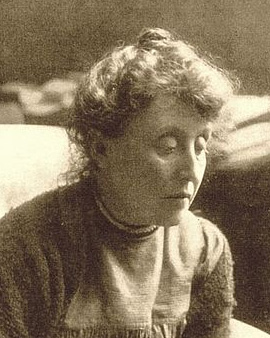


Evelyn De Morgan was one of the few very successful English artists of her time. Women were severely underrepresented in the arts at the time. She belonged to the Pre-Raphaelite group. This group of artists formed in England in the middle of the 19th century. With their work the group created its own style, Pre-Raphaelism. This style was based on late medieval Italian art. Historical depictions were often the subject of Pre-Raphaelite works. However, these representations did not serve art, but were rather intended to provide food for thought for social changes.
Evelyn De Morgan comes from a middle-class household. At the age of 15 she was home-schooled. Her mother attached great importance to Evelyn receiving the same education as her brother. Therefore, in addition to painting and drawing, she learned various languages, including Greek, Latin, French, German and Italian, and received lessons in literature, mythology and history. In addition, she was occupied with scientific topics. Her uncle John Roddam Spencer Stanhope was an artist himself and influenced her own artistic work. Stanhope lived in Florence. Whenever she could, Evelyn visited her uncle in Italy. She used the time there to get to know the Italian art of the Renaissance. During this time she discovered her interest in the works of the important Italian painter Sandro Botticelli.
De Morgan's works seem to be full of love for detail and a little playful. She often depicted women in mythological and spiritual scenes. The female body received special attention in almost all her works. Today we can say that the artist expressed feminist values in an intelligent way with her elaborate paintings. The typical metaphors like light and darkness or transformation can be found in De Morgan's paintings. She also drew attention to the social situation of women in other areas. In 1889 she signed a declaration on the introduction of the right to vote for women. Her works of art also show her pacifist view, for the artist was a vehement opponent of war. Evelyn De Morgan was professionally interested exclusively in art and painting. She had to fight hard for recognition in the art scene, after all she was a woman. She always had a mind of her own, which helped her in her career plans. So she began studying at the National Art Training School (today: Royal College of Art) in 1872 and in 1873 at the Slade School of Art, where women were admitted to study for the first time at that time. The talented artist received a scholarship and was awarded prizes for her works during her studies. In 1887 she married the ceramic artist William de Morgan. Initially, Evelyn supported her husband financially with the income from sales of her works of art. Later her husband succeeded in publishing a successful novel. The income from this provided financial relaxation and additional freedom. The artist died in London in 1919, just under two years after her husband's death.

Evelyn De Morgan was one of the few very successful English artists of her time. Women were severely underrepresented in the arts at the time. She belonged to the Pre-Raphaelite group. This group of artists formed in England in the middle of the 19th century. With their work the group created its own style, Pre-Raphaelism. This style was based on late medieval Italian art. Historical depictions were often the subject of Pre-Raphaelite works. However, these representations did not serve art, but were rather intended to provide food for thought for social changes.
Evelyn De Morgan comes from a middle-class household. At the age of 15 she was home-schooled. Her mother attached great importance to Evelyn receiving the same education as her brother. Therefore, in addition to painting and drawing, she learned various languages, including Greek, Latin, French, German and Italian, and received lessons in literature, mythology and history. In addition, she was occupied with scientific topics. Her uncle John Roddam Spencer Stanhope was an artist himself and influenced her own artistic work. Stanhope lived in Florence. Whenever she could, Evelyn visited her uncle in Italy. She used the time there to get to know the Italian art of the Renaissance. During this time she discovered her interest in the works of the important Italian painter Sandro Botticelli.
De Morgan's works seem to be full of love for detail and a little playful. She often depicted women in mythological and spiritual scenes. The female body received special attention in almost all her works. Today we can say that the artist expressed feminist values in an intelligent way with her elaborate paintings. The typical metaphors like light and darkness or transformation can be found in De Morgan's paintings. She also drew attention to the social situation of women in other areas. In 1889 she signed a declaration on the introduction of the right to vote for women. Her works of art also show her pacifist view, for the artist was a vehement opponent of war. Evelyn De Morgan was professionally interested exclusively in art and painting. She had to fight hard for recognition in the art scene, after all she was a woman. She always had a mind of her own, which helped her in her career plans. So she began studying at the National Art Training School (today: Royal College of Art) in 1872 and in 1873 at the Slade School of Art, where women were admitted to study for the first time at that time. The talented artist received a scholarship and was awarded prizes for her works during her studies. In 1887 she married the ceramic artist William de Morgan. Initially, Evelyn supported her husband financially with the income from sales of her works of art. Later her husband succeeded in publishing a successful novel. The income from this provided financial relaxation and additional freedom. The artist died in London in 1919, just under two years after her husband's death.
Page 1 / 2






